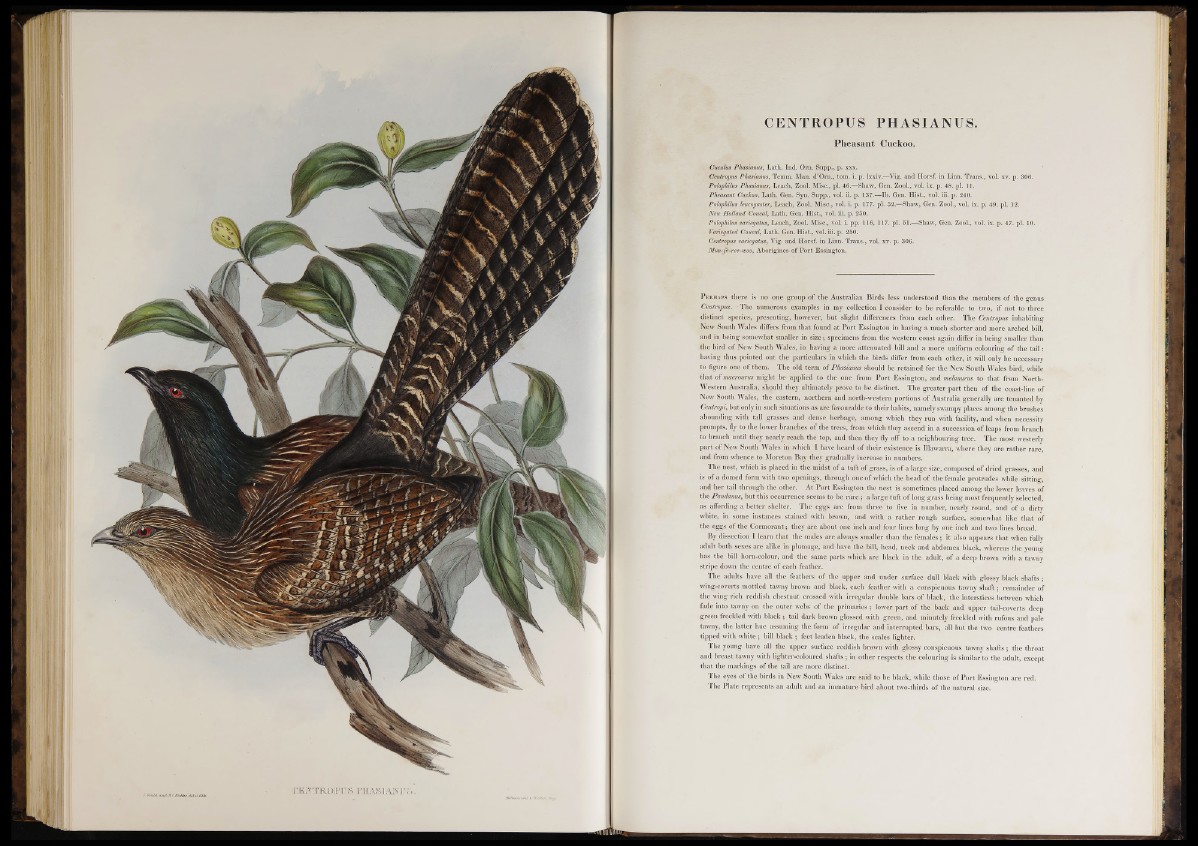
CENTROPUS PHASIANUS.
Pheasant Cuckoo.
Cucuhts Phasianus, Lath. Ind. Om. Supp., p. xxx.
Centropus Phasianus, Temm. Man. d’Orn., tom. i. p. lxxiv.—Vig. and Horsf. in Linn. Trans., vol. xv. p. 306.
Polophilus Phasianus, Leach, Zool. Misc., pi. 46.—Shaw, Gen. Zool., vol. ix. p. 48. pi. 11.
Pheasant Cuckoo, Lath. Gen. Syn. Supp., vol. ii. p. 137.—Ib. Gen. Hist., vol. iii. p. 240.
Polophilus leucogaster, Leach, Zool. Misc., vol. i. p. 177. pi. 52.—Shaw, Gen. Zool., vol. ix. p. 49. pi. 12.
New Holland Coucal, Lath. Gen. Hist., vol. iii. p. 250.
Polophilus variegatus, Leach, Zool. Misc., vol. i. pp. 116, 117. pi. 51.—Shaw, Gen. Zool., vol. ix. p. 47. pi. 10.
Variegated Coucal, Lath. Gen. Hist., vol. iii. p. 250.
Centropus variegatus, Vig. and Horsf. in Linn. Trans., vol. xy. p. 306.
Mun-je-ree~woo, Aborigines of Port Essington.
P e r h a p s there is no one group of the Australian Birds less understood than the members of the genus
Centropus. The numerous examples in my collection I consider to be referable to two, if not to three
distinct species, presenting, however, but slight differences from each other. The Centropus inhabiting
New South Wales differs from that found at Port Essington in having a much shorter and more arched bill,
and in being somewhat smaller in size; specimens from the western coast again differ in being smaller than
the bird of New South Wales, in having a more attenuated hill and a more uniform colouring o f the tail :
having thus pointed out the particulars in which the birds differ from each other, it will only be necessary
to figure one o f them. The old term o f Phasianus should be retained for the New South Wales bird, while
that o f macrourus might be applied to the one from Port Essington, and melanurus to that from North-
Western Australia, should they ultimately prove to be distinct. The greater part then of the coast-line of
New South Wales, the eastern, northern and north-western portions of Australia generally are tenanted by
Centropi, but only in such situations as are favourable to their habits, namely swampy places among the brushes
abounding with tall grasses and dense herbage, among which they run with facility, and when necessity
prompts, fly to the lower branches of the trees, from which they ascend in a succession of leaps from branch
to branch until they nearly reach the top, and then they fly off to a neighbouring tree. The most westerly
part of New South Wales in which I have heard o f their existence is Illawarra, where they are rather rare,
and from whence to Moreton Bay they gradually increase in numbers.
The nest, which is placed in the midst of a tuft o f grass, is o f a large size, composed o f dried grasses, and
is of a domed form with two openings, through one of which the head o f the female protrudes while sitting,
and her tail through the other. At Port Essington the nest is sometimes placed among the lower leaves of
the Pandanus, but this occurrence seems to be rare; a large tuft of long grass being most frequently selected,
as affording a better shelter. The eggs are from three to five in number, nearly round, and of a dirty
white, in some instances stained with brown, and with a rather rough surface, somewhat like that of
the eggs of the Cormorant; they are about one inch and four lines long by one inch and two lines broad.
By dissection I learn that the males are always smaller than the females; it also appears that when fully
adult both sexes are alike in plumage, and have the bill, head, neck and abdomen black, whereas the young
has the bill horn-colour, and the same parts which are black in the adult, of a deep brown with a tawny
stripe down the centre of each feather.
The adults have all the feathers o f the upper and under surface dull black with glossy black shafts;
wing-coverts mottled tawny brown and black, each feather with a conspicuous tawny shaft; remainder of
the wing rich reddish chestnut crossed with irregular double bars o f black, the interstices between which
fade into tawny on the outer webs of the primaries; lower part of the back and upper tail-coverts deep
green freckled with black ; tail dark brown glossed with green, and minutely freckled with rufous and pale
tawny, the latter hue assuming the form of irregular and interrupted bars, all but the two centre feathers
tipped with white ; bill black ; feet leaden black, the scales lighter.
The young have all the upper surface reddish brown with glossy conspicuous tawny shafts; the throat
and breast tawny with lighter-coloured shafts; in other respects the colouring is similar to the adult, except
that the markings of the tail are more distinct.
The eyes of the birds in New South Wales are said to he black, while those of Port Essington are red.
The Plate represents an adult and an immature bird about two-thirds of the natural size.